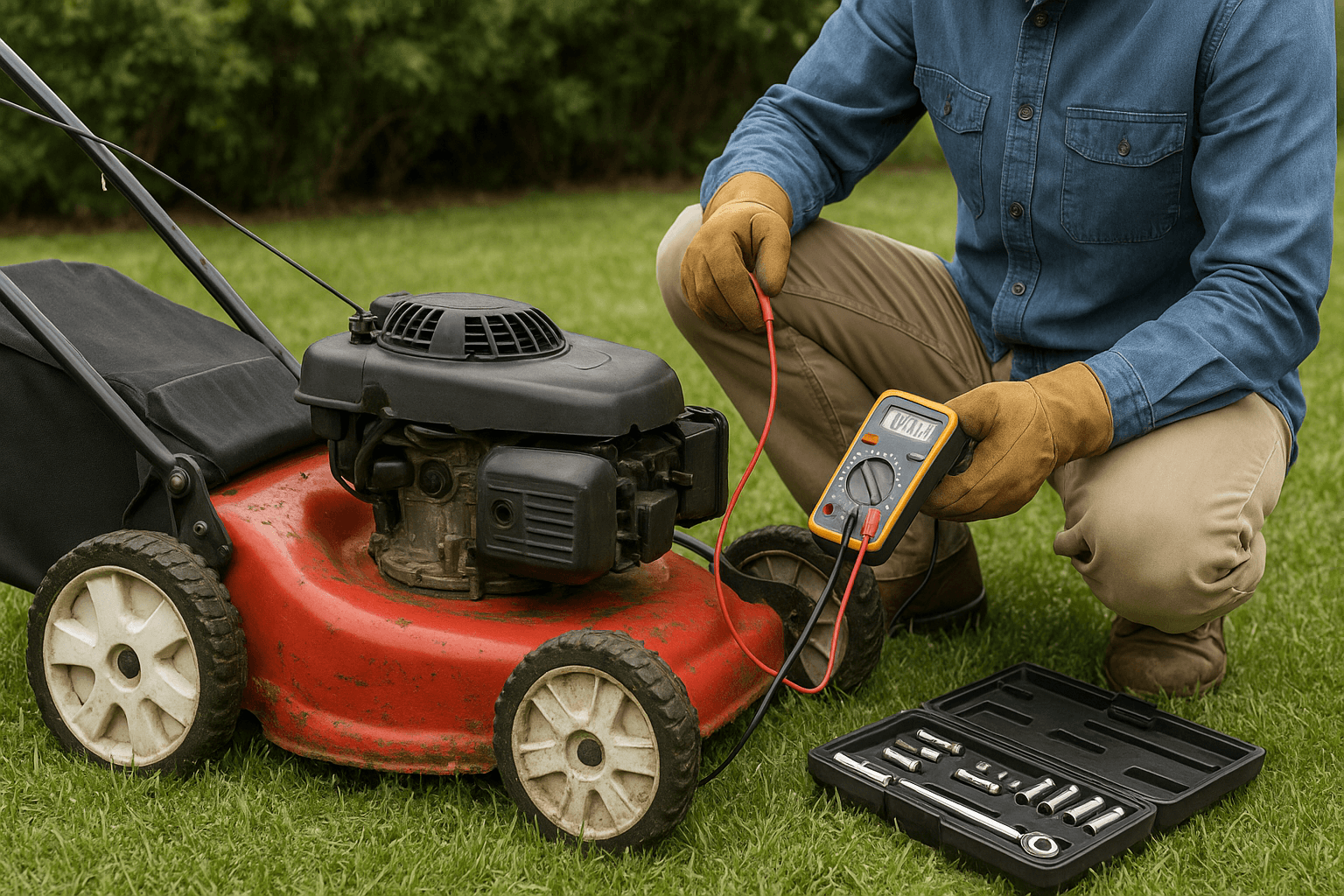Repair help
Why Does My Lawn Mower Backfire? Common Causes and Fixes
AZparts Team
Updated on November 19, 2025
6 min read
A lawn mower is an essential tool that makes garden maintenance faster and more efficient. However, during use, many people encounter the issue of lawn mower backfiring, which causes loud popping noises and interrupts the work. This phenomenon not only causes discomfort but also poses a risk of damaging the engine if not addressed promptly. In this article, AZParts will help you understand the common causes of lawn mower backfiring and effective ways to fix it, helping you keep your equipment running smoothly and reliably.

1. What Causes a Lawn Mower to Backfire?
Fuel Issues
- Old or stale fuel is one of the popular causes my lawn mower to backfire
- Wrong fuel type (low quality, too much ethanol).
Air & Ignition Problems
- Dirty/clogged lawn mower air filter → unbalanced fuel-air mix.
- Faulty or dirty spark plug → weak/mistimed spark.
- Poor lawn mower carburetor adjustment (too rich/lean) or clogged passages.
Timing & Mechanical Failures
- Worn or misaligned flywheel key → wrong ignition timing.
- Ignition system parts too early/late → unburned fuel escapes then ignites.
- Compression loss (damaged lawn mower gasket, piston, rings).
- Faulty intake/exhaust valves (bent, leaking, mistimed).
External Factors
- Engine overheating → premature fuel ignition.
- Sudden shutdown at high RPM → leftover fuel ignites in exhaust.

Old or stale fuel is one of the common causes of backfiring in lawn mowers (Source: AZParts)
Check out more: How to Clean My Lawn Mower to Extend Lifespan
2. How to Fix Lawn Mower Backfiring
2.1. Inspect and replace bad fuel
Old or oxidized fuel can degrade the quality of the air-fuel mixture, leading to incomplete combustion and backfiring. If you notice that the fuel has been sitting for too long or suspect its quality, it’s recommended to drain the old fuel and replace it with fresh fuel of the correct type as specified by the lawn mower manufacturer. Using clean, uncontaminated gasoline helps the engine run more smoothly and reduces the risk of backfire.
2.2. Clean or replace the air filter
A dirty or clogged air filter restricts airflow to the combustion chamber, which alters the air-fuel ratio, making it too rich or too lean. This imbalance can cause uneven combustion and result in backfiring. Regularly check your air filter and clean it using appropriate solutions or by blowing off dust. Replace the filter if it becomes too dirty or damaged.
2.3. Check and replace spark plug
The spark plug plays a crucial role in igniting the air-fuel mixture in the combustion chamber. When the spark plug is dirty, worn out, or damaged, it may produce a weak or mistimed spark, resulting in inefficient combustion and an increased risk of backfire. Periodically inspect your spark plug, clean it, or replace it when necessary to ensure optimal engine performance. Choosing a high-quality spark plug not only helps your mower run smoothly but also reduces ignition-related issues.
2.4. Inspect carburetor (clean or adjust)
The carburetor is responsible for regulating the air-fuel ratio entering the engine. If it becomes dirty or clogged with fuel deposits, it may disrupt fuel delivery and airflow, causing uneven combustion and backfiring. To fix this, carefully remove and clean the carburetor, and adjust it according to the manufacturer’s specifications.

The carburetor is responsible for regulating the air-fuel ratio entering the engine (Source: AZParts)
2.5. Check flywheel key and ignition system
The flywheel key is a small but vital component that synchronizes the flywheel and crankshaft to ensure proper ignition timing. If the flywheel key is misaligned, broken, or damaged, ignition timing will be off, potentially causing backfire or unstable engine operation. Additionally, components in the ignition system, such as coils and spark plugs should also be inspected, maintained, or replaced as needed.
2.6. Avoid shutting off throttle at high RPM
Abruptly turning off the engine while it's running at high RPM can cause leftover fuel in the combustion chamber or exhaust system to ignite unintentionally due to residual heat, resulting in a loud backfire and potential damage to engine components.
To prevent this, always reduce engine speed to low RPM before shutting it off, and allow the engine to cool down briefly. This habit not only minimizes the risk of backfiring but also extends the lifespan of your lawn mower.

Avoid shutting off throttle at high RPM (Source: Freepik)
3. How to Prevent Backfiring in Lawn Mowers
- Use fresh, correct fuel: Always use the recommended fuel grade. Avoid stale or ethanol-heavy fuel to reduce the risk of lawn mower backfire.
- Do regular maintenance: Check spark plugs, clean/replace air filters, and adjust the carburetor to keep the engine in top condition.
- Cool engine before shutdown: Let the mower idle for a minute before turning it off. This helps burn leftover fuel and prevents lawnmower backfire.
- Keep parts clean: Clean or replace spark plugs and air filters regularly for a proper fuel-air mix and smooth ignition. Use lawn mower cover to protect lawn mowers in restoring time.
4. FAQs About Mower Backfiring
4.1. Will a bad spark plug cause backfiring?
Yes. A spark plug that is dirty, worn out, or damaged can lead to weak or mistimed sparks, resulting in inefficient fuel combustion and increasing the likelihood of backfiring.
4.2. Does backfire hurt the engine?
Yes. Backfiring can harm components such as the spark plug, exhaust valve, and carburetor. If the issue occurs frequently and is not promptly addressed, it may reduce the overall lifespan of the engine.
4.3. Is backfiring common in all mower types?
Not entirely. Backfiring is more commonly found in older lawn mowers, particularly those with 2-stroke gasoline engines or units that have not been well maintained. Newer models with 4-stroke engines and proper upkeep are less likely to experience this issue.
4.4. How do I prevent mower backfire when shutting it off?
To prevent backfiring, gradually reduce the engine speed to idle before shutting it off. Avoid stopping the engine abruptly while it's still running at high RPM. Also, allowing the engine to cool down for a few moments before turning it off completely helps burn off any remaining fuel and reduces the risk of backfiring.
4.5. Why does my lawn mower backfire when i turn it off
A lawn mower backfire when shutting off usually happens if the engine is turned off too quickly while running at high speed, leaving unburned fuel in the hot exhaust. Other causes include overheating, stale fuel, or carburetor misadjustment. To prevent lawnmower backfire, let the engine idle briefly before switching it off.
Backfiring in lawn mowers is not only bothersome but can also negatively affect engine performance and longevity. Understanding the common causes, such as poor-quality fuel, dirty spark plugs, carburetor issues, or incorrect ignition timing will help you quickly identify and resolve the issue. Regular lawn mower maintenance, using genuine replacement parts, and following proper operating procedures are key to preventing this problem effectively.
If you need replacement parts for your lawn mower, AZParts is here to support you with high-quality products and dedicated service helping your mower run more reliably and efficiently every day.
Contact Information:
8 The Green, Ste A, Dover, Delaware 19901-3618, United States
Read more:
Lawn Mower
Further Reading
Further Reading





